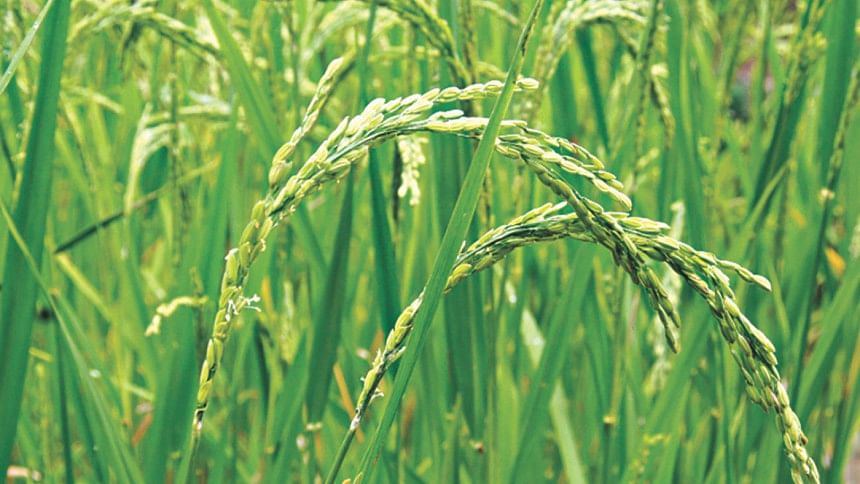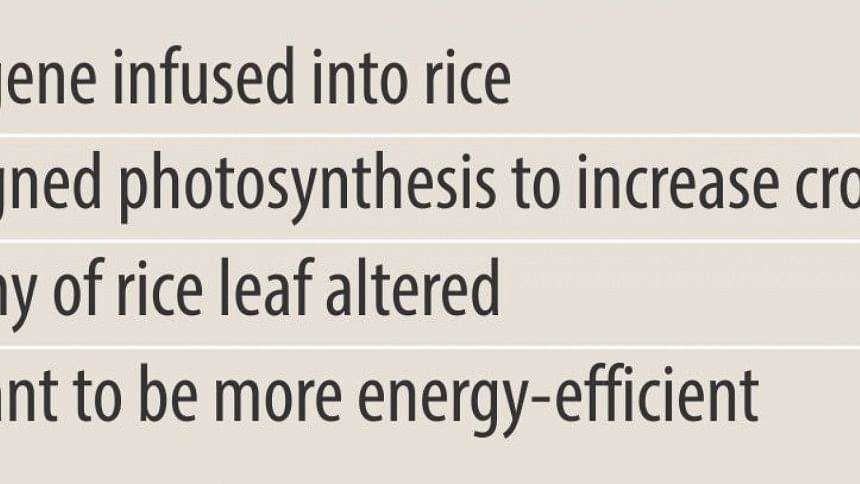'Super rice' in sight

Scientists have long been considering the idea of engineering rice plant in a way that the global production of the cereal gets a dramatic boost.
The idea came from the concern that the traditional research, which results in just one percent rise in the yearly yield, would not be enough to meet the ever-growing demand.
So the plan was to convert rice into a photosynthesis-efficient plant, which would produce substantially more grains using the sunlight.
Nine years into the initiation of an ambitious rice plant engineering project, a group of scientists have recently declared a major breakthrough in improving photosynthesis for the cereal.
They said this would change the plant architecture of rice once for all, make it more energy-efficient and thereby, increase the yield of the world's third most consumed grain, after maize and wheat, by 50 percent. It would eventually help meet the food needs of billions of people around the world, including Bangladesh.
During photosynthesis, plants take carbon dioxide, water, and light, and turn them into sugar and oxygen. The sugar is then used by the plants for food, and the oxygen is released into the atmosphere.
Rice uses the C3 photosynthetic pathway, which in hot and dry environments is much less efficient than the C4 pathway used by other plants such as maize, sugarcane and sorghum. Scientists thought that if rice could "switch" to use C4 photosynthesis, its productivity would increase by 50 percent.
Scientists and researchers drawn from 12 institutions in eight countries declared on October 19 that they have achieved a major breakthrough by being able to engineer the rice plant accordingly. They are involved with the C4 Rice Project, often dubbed as "grand challenge" of the 21st century.
University of Oxford, one of the 12 institutions which are at the forefront of this multi-billion dollar 15-year mega project, has issued a press release, saying the scientists have been able to infuse a single maize gene into rice leaf thereby finishing off the first step of converting rice into a C4 plant.

The same day, one of the world's leading scientific journal -- Current Biology -- twitted, "a key step in engineering #rice #plant with more efficient C4 #photosynthesis has been achieved."
Jane A Langdale and Peng Wang of the Plant Sciences Department of the University of Oxford along with eight other scientists involved with the C4 Rice Project published an article in the current issue of the Current Biology.
They declared in the journal that a key step towards engineering C4 rice has been achieved through introducing a maize gene (GOLDEN2-like) in C3 rice leaves that is reminiscent of proto-Kranz anatomy, an intermediate state in the evolutionary trajectory from C3 to C4. A C4 has a special leaf anatomy called 'Kranz anatomy' and C4 plant is better adapted than a C3 plant in an environment with high daytime temperatures, intense sunlight, drought, or nitrogen or CO2 limitation.
Over three billion people, including 160 million in Bangladesh, depend on rice for survival, and owing to predicted population increases and a general trend towards urbanisation, land that provided enough rice to feed 27 people in 2010 will need to support 43 by 2050.
"In this context, rice yields need to increase substantially over the next 35 years. Given that traditional breeding programmes currently achieve around a 1% increase in yield per annum, this is not a trivial endeavour," said Oxford University's Prof Jane Langdale, current principal investigator of the C4 Rice Project.
Prof Julian Hibberd, who teaches photosynthesis at the University of Cambridge and also a member of the C4 consortium, said, "The C4 pathway is an extremely complex and remarkable piece of evolution… "
He said, "Although engineering the efficient C4 pathway into C3 crops would enable a step-change in agricultural productivity, the large number of changes required to convert a C3 leaf to one that uses C4 photosynthesis has rightly been seen as a major challenge to implementation."
The C4 Rice Project is an international collaboration between 18 research groups, from the 12 institutions in eight countries. The institutions are: Australian National University (Australia), University of Toronto (Canada), Chinese Academy of Sciences (China), Max Planck Institute of Molecular Plant Physiology and Heinrich Heine University (Germany), International Rice Research Institute (IRRI) (the Philippines), Academia Sinica Institute of Molecular Biology (Taipei), University of Cambridge and University of Oxford (UK), Donald Danforth Center, Washington State University, and University of Minnesota (USA).
Bangladesh Rice Research Institute's (BRRI) Director General Shahjahan Kabir told The Daily Star that this breakthrough in rice engineering ushered in a new hope for countries like Bangladesh, where growing more food from increasingly scarce land and water resources is getting difficult.
"We'll engage our rice scientists in the C4 rice research in partnership with the IRRI [International Rice Research Institute] as we did in the past in the case of developing submergence-tolerant rice," Kabir added.
Zeba Islam Seraj, who teaches biochemistry and molecular biology at the University of Dhaka and has a long experience of rice breeding, said, "Maize, sorghum and sugarcane are C4 photo-synthesisers, while rice is C3. C4 photo-synthesisers are more efficient in energy uptake."
She also termed this breakthrough as a first step towards converting C3 rice to more efficient C4 rice. She said C4 species such as maize and sorghum are more efficient at carbon assimilation than C3 species, and in addition they display greater water use efficiency, better nitrogen use efficiency and higher-temperature tolerance.
The C4 Rice Project was first conceived by John Sheehy, a plant physiologist who was the head of the Applied Photosynthesis Group at the IRRI from 1995 to 2009. The costs of the project were estimated to be about $5m per year. In October 2008, the Bill & Melinda Gates Foundation awarded IRRI a grant of $11.1 million to begin the research. Currently the project is into its phase-III (2015-2019).
Experts noted that successful completion of engineering rice into a C4 plant would be a "game-changer" since the '60s of last century when scientists had first developed semi-dwarf rice varieties heralding the famous "Green Revolution".

 For all latest news, follow The Daily Star's Google News channel.
For all latest news, follow The Daily Star's Google News channel. 



Comments